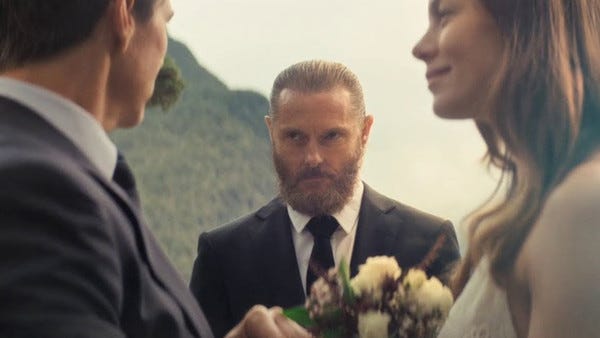"Dear Beloved..." - Thomas Cranmer, Tom Cruise, and the Purpose of Marriage
Part Five: Thomas Cranmer’s Top Ten Prayers, Phrases, and Proclamations That Shape Our Faith
This summer, we are turning to the words and world of Thomas Cranmer, the English Reformer and first Archbishop of Canterbury. I hope you will join me.
For nearly five centuries, the words of Thomas Cranmer have shaped the way English-speaking Christians pray, confess, marry, mourn, and meet God.
In this series, I’m revisiting ten of his most enduring lines—not just to admire their beauty, but to understand their force. These are sentences that still preach, still form us, and echo in hospital rooms and wedding chapels. They still rise before the throne of God every Sunday.
Today we go back to the Wedding Ceremony in the Book of Common Prayer…
Deerely beloved frendes…
DEERELY beloved frendes, we are gathered together here in the syght of God, and in the face of his congregacion, to joyne together this man and this woman in holy matrimonie,
— Thomas Cranmer, The Book of Common Prayer (1549)
I recently watched a Mission Impossible movie—one of the newer ones—where Ethan Hunt, the fearless secret agent, finds himself in a surreal dream sequence of a wedding. There was no explanation needed. A priest stood ready, prompting the couple with their vows line by line. (The fact that the priest was Ethan Hunt's arch-nemesis is not important to the point.) A bride and groom faced each other. Vows were spoken.
The audience knew exactly what was happening, even in a dream.
What struck me wasn’t just the emotional undercurrent of the scene, but the language. The familiarity of it. The moral gravity it tried to assert—the cadence.
The movie echoed the words that have been spoken at altars and churches, cathedrals and country chapels, for centuries. And it brought to mind one remarkable fact:
Thomas Cranmer wrote the wedding script for the modern Western world.
Imagine Cranmer—a Tudor-era archbishop and reluctant revolutionary—penning lines that would be used in spy thrillers, rom-coms, sitcoms, beach weddings, church liturgies, and royal weddings five centuries later. It sounds unlikely. But it happened.
Dearly Beloved…
“Dearly Beloved.” Is there any more recognized phrase in our English language?
Two words—and suddenly we know where we are: at a wedding, standing before God and man, with a vow about to be spoken and a life about to be changed.
And then the opening paragraph of his marriage rite deserves close attention not only for its literary elegance but also for its theological depth and cultural legacy.
Let’s examine what he wrote.
The Opening Words
Here is the first paragraph of the 1549 wedding rite, slightly updated for clarity:
Dearly beloved friends, we are gathered here in the sight of God, and in the face of this congregation, to join together this man and this woman in holy matrimony. It is an honorable estate, instituted by God in paradise, in the time of man’s innocency. It signifies the mystical union between Christ and his Church. This estate was adorned by Christ’s presence and first miracle at Cana of Galilee, and is commended by Saint Paul as honorable among all men. Therefore, it must not be entered into unadvisedly, lightly, or wantonly, to satisfy carnal lusts like brute beasts, but reverently, discreetly, advisedly, soberly, and in the fear of God.
Considering the causes for which matrimony was ordained:
First, for the procreation of children, to be raised in the fear and nurture of the Lord.
Second, for a remedy against sin and to avoid fornication, that those who marry may live chastely.
Third, for mutual society, help, and comfort, both in prosperity and adversity.
Into this holy estate these two persons now come to be joined. Therefore, if anyone can show just cause why they may not lawfully be joined together, let him speak now, or forever hold his peace.
(Take you chances on the original English. 1
Theological and Poetic Design
This paragraph is more than just an introduction—it serves as a brief theological homily.
Cranmer begins not with the couple but with God and the assembled community. The act is public and sacred. It’s not a private ceremony of love but a covenant made in the sight of God and His congregation.
As a priest of the church, I made it part of my premarital counseling to go through the first paragraph of the marriage service line by line, almost like delivering a sermon. In this way, I emphasized that weddings are never private; they are open events. No one should be prevented from attending, including jilted lovers, former partners, or unsupportive parents. The church should remain open. (This further explains why later in the service, the priest asks for any objections to the marriage to be made known publicly.)
Marriage, we’re told, was instituted by God in Eden, before sin entered the world. That phrase “in the time of man’s innocency”, grounds matrimony not in culture or convenience, but in creation.
It is a divine design, not a human invention. Marriage, I would always explain, was God’s idea. It is God’s invention, an upgrade after creation. And since it is His idea, it was not ours to tinker with or redefine.
Then Cranmer does something sharp. He pulls us from Eden to Cana, from the first chapters of Genesis to the wedding at the start of John’s Gospel. And in that move, he doesn’t just historicize marriage—he sacramentalizes it.
Marriage, he says, isn’t only old. It points to something eternal. It signifies “the mystical union that is betwixt Christ and His Church.” That’s Ephesians 5, straight up: the love between husband and wife as a mirror of Christ’s self-giving love for the Church.
But just as we might drift into warm sentiment, Cranmer drops the hammer.
Keep reading with a 7-day free trial
Subscribe to The Anglican to keep reading this post and get 7 days of free access to the full post archives.






